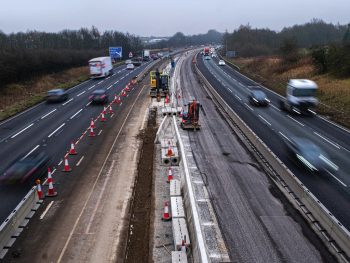Comment: Should smart motorways really be scrapped?
Amid extensive negative press and mounting public fear, our editor-at-large, Alex Grant, wonders if smart motorways deserve their deadly reputation.

Amid extensive negative press, do smart motorways deserve their deadly reputation?
In a world of clickbait headlines and social media soundbites, nuance is becoming increasingly rare. From politics to powertrains, the most complicated and important conversations often get bogged down in entrenched opinions and emotion, while solutions bob around, unnoticed, in the grey area. It’s a blunt way to solve problems – and the rise and fall of smart motorways is a shining example of the result.
There are three types of ‘smart’ motorway in the UK: controlled (using overhead signs); dynamic hard shoulder and permanent all-lane running. They were introduced in 1995, 2006 and 2014 respectively and now span a combined 269 miles of carriageway. These motorways are designed to improve traffic flow by managing speed and lane discipline, effectively (or actively) expanding road capacity without laying additional tarmac. I’m also told, frequently, that they’re lethal.
That sentiment is hardly surprising. Several prominent organisations launched high-profile campaigns targeting prime-time media and the highest levels of government, often focused on the risks of drivers breaking down in live lanes. By last summer it had become an issue of such magnitude that both Rishi Sunak and Liz Truss promised to address it in their leadership campaigns. In April, all future schemes were scrapped due to “cost pressures” and a “lack of public confidence”.
The reality is less alarming. Although it hasn’t taken long for pre-pandemic congestion to return (total vehicle mileage is about 5% lower than it was in 2019), the UK has one of the world’s safest road networks. The latest European Transport Safety Council data shows only Norway and Sweden had a lower accident rate per kilometre driven in 2021, while Department for Transport figures reflect a 22.6% reduction in people killed or seriously injured on the strategic road network (SRN) in the decade to 2019. Covid makes later years harder to compare.
Motorways are safer still. According to the DfT, they accounted for 20% of traffic (by miles driven) in 2021, but only 2.6% of fatal or serious injuries. Presumably, then, converting them to smart motorways tips the apple cart? National Highways data suggests otherwise. Between 2016 and 2020, smart motorways had a lower rate of serious and fatal injury rates per hundred million vehicle miles than conventional ones. For reference, serious and fatal injury rates are around two and half times higher still on the SRN’s A-roads.
So, what about live lane fatalities? Between 2016 and 2020, drivers were twice as likely to be killed in live lane collisions involving a stopped car on stretches with all-lane running or a dynamic hard shoulder than on a conventional motorway. However, those incidents are (thankfully) rare enough that it’s statistically difficult to draw solid conclusions from them. You are four times more likely to be killed in a collision between two moving vehicles on a conventional motorway than one involving a stopped vehicle on a stretch with part-time or absent hard shoulders.
Of course, smart motorways also tend to be on the busiest, slowest sections of our motorway network, which will influence the severity of any collisions. The most recent analysis also misses out on the influence of new closed-lane enforcement cameras and radar-based stopped vehicle detection, rolled out last year. Yes, the Office of Rail and Road issued a damning and often-cited report about the latter not meeting its targets, but even this noted that a software update piloted on one stretch of road had closed the gap, adding that it was too early to make any conclusions.
If this comes across as blinkered smart motorway advocacy, then that’s not my intention. Every life lost is a tragedy and there is certainly room for improvement, but learning requires ongoing conversations rather than soundbites and political point-scoring. As usual, I suspect the solutions lie somewhere within the grey area.
3 Comments
-
John Watts18. Aug, 2023
The reason why smart motorways are dangerous is because most motorists have no idea what a two second space between vehicles is and travel fR too close together. If you break down the following vehicle is unable to avoid you. 2 seconds at 70 mph is 14 car lengths.
-
Martin Evans15. Aug, 2023
Smart motorways are at least as safe than conventional ones – but much of the media and some vocal public opinion
still claims they are dangerous, death traps!
It’s a shame many people don’t actually look at the collision and fatal statistics but use their ‘experience’ to castigate them.
Public education needs much work.













Gareth Allen18. Aug, 2023
As a professional driver for 30 years, I think Smart Motorways are a good thing
BUT there are not enough emergency laybys in the planning and they aren’t long enough with regards to HGV vehicles.